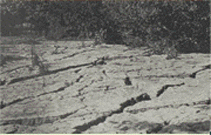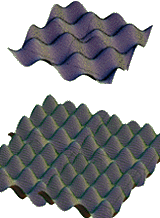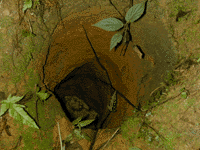Cockpit Country in Jamaica is the type location for
cockpit karst. Cockpit Country was the name given to the area by
the British during the First Maroon War (~1730-1738) because it reminded them of the "cockpit" in the aft lower deck of a man-of-war where the wounded were taken (MerriamWebster Dictionary gives the "ORIGIN late 16th cent. (sense 2) : from cock 1 + pit 1 . In the early 18th cent. the term was in nautical use, denoting an area in the aft lower deck of a man-of-war where the wounded were taken, later coming to mean [the ÒpitÓ or well in a sailing yacht from which it was steered] ; hence the place housing the controls of other vehicles ( sense 1, early 20th cent.).
The word "karst" derives from 'Kras' in
Slovenia:- "a dry, waterless place". Although the Cockpit Country
receives high rainfall annually (1500mm to 2500mm), it is still
considered "waterless" because limestone acts as a sponge: surface
water is drained vertically and rapidly and each cockpit bottom
("sink") is drained by a sinkhole. (seemovie)
Don't hike without a guide! (See one group's experience)
 |
 |
|
The formation of Cockpit Country started about 12 million years ago with a faulted limestone plateau when Jamaica emerged from the sea. The plateau rose to about 600m (2000ft) above sea level. Erosion of this plateau formed the regular array of round-topped, conical hills and sinks that we know today. There are at least two theories as to how cockpit karst forms (see movie). The "solution" theory holds that heavy tropical rainfall washing through a fissured limestone plateau over millions of years dissolved and eroded the fissures and washed the debris through the sinkholes eventually out to sea.A recent researcher measured the orientation of the faults in the area and found them to be largely aligned along three primary axes mutually at 120 degrees. |
 |
|
He surmises that a sinkhole forms when three faults intersect.This theory provides an explanation of the typical, regularly-spaced, round-topped, conical hills.At the top of the hill, the water moves slowly so that little erosion takes place; as the water runs down the hill, it gathers momentum and also gathers debris so that its scouring action becomes more and more pronounced. This accounts for the slope being so steep at the base. Of course, each cockpit has one or several sinkholes but there is a tendency for these to become blocked by debris. |
 |
One of the puzzles for a layman is how the bottom of each cockpit is so flat: this is because, during times of heavy rain, water also comes UP the sinkholes and floods the sink or cockpit. It is this flooding over the millenia which redistributes debris over the entire bottom of the sink.
The other "collapse" theory maintains that the formation and subsequent collapse of cave systems is the primary mechanism for cockpit karst formation. It is not generally realised that caves in limestone hills have a finite life as they migrate upwards through the hillside. This migration is caused by successive collapses of the ceiling due to the solutional effects of water percolating downwards. Obviously, every time the ceiling collapses, the ceiling gets higher and the floor is raised by the debris: so the whole chamber gets higher. Eventually the cave opens to the sky.
We value your feedback and comments: E-mail us